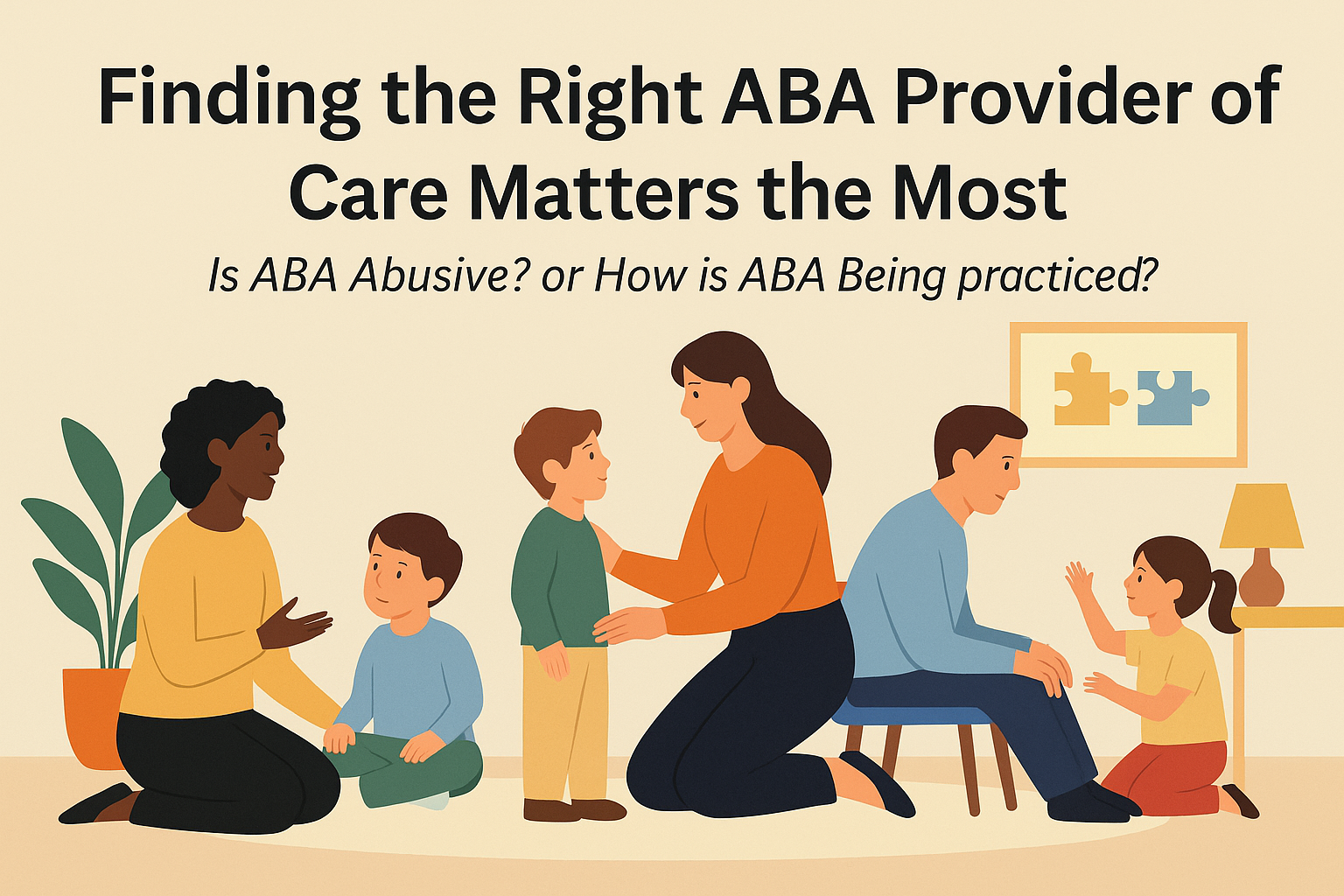HB Field
Nia Berrian •
August 28, 2025
Finding the Right ABA Provider of Care Matters the Most
ABA Provider
ABA Care

Finding the Right ABA Provider of Care Matters the Most
By Nia Berrian, M.S; BCBA
Is ABA Abusive? Or How is ABA Being Practiced?
ABA Therapy: Why the Approach Matters Most
As a parent or caregiver, you want the very best for your child. When you first hear about Applied Behavior Analysis (ABA) therapy, it’s natural to have questions and sometimes even concerns.
You may have come across articles, posts, or personal stories that describe ABA as harsh or overly focused on compliance. These perspectives can feel alarming, and reactions can be mixed. Most parents and caregivers feel hesitant.
It’s important to understand: ABA itself is not abusive. Like many tools, it can be used in ways that are either supportive or harmful if misapplied. What truly makes the difference is the approach of the provider.
Certainly, ABA therapy has a controversial past. Some autistic adults who experienced ABA therapy years ago describe it as traumatizing and coercive, citing feelings of being controlled, silenced, or taught to mask their true selves. Critics argue that ABA can overemphasize “normalizing” behaviors (eye contact, sitting still) at the expense of honoring the child’s natural communication and identity.
Today, however, ethical standards emphasize:
- Reinforcement over punishment
- Teaching functional skills
- Reducing harmful behaviors without negatively impacting emotional states
- Individualizing programs around family values and the child’s strengths
ABA is the most researched intervention for autism, with significant empirical support for improving outcomes when implemented ethically, with compassion, and with respect toward the recipient of services.
The Truth About ABA
At its core, ABA is simply a science-based method for teaching skills and reducing barriers that may hinder a child’s growth.
It uses:
- Reinforcement-based and motivational strategies
- Step-by-step teaching methods
- Careful observation
to help children learn communication, social, and daily living skills.
Key Point: ABA is not a “one-size-fits-all” therapy.
How ABA is practiced depends entirely on the provider.
- A rigid, compliance-only model can feel frustrating and disempowering.
- An approach rooted in compassion, flexibility, and respect can empower children and make therapy joyful.
Why the ABA Provider’s Approach Matters
Children thrive when therapy feels safe, fun, and meaningful. At BH Field, we focus on:
- Compassion-Driven Care: We see the whole child, not just behaviors. Every session is designed with empathy and respect.
- Child-Led Learning: We follow your child’s interests and motivation, making therapy engaging and natural instead of forced.
- Motivation and Joy: Therapy incorporates children’s interests—favorite toys, games, or routines.
- Family Collaboration: We work with caregivers as partners to ensure therapy goals align with family values and daily life.
- Skill-Building for Life: We emphasize real-world skills that help children thrive socially, emotionally, and academically.
Why Families Choose BH Field
Parents and caregivers come to us because they want their child to receive ABA therapy that honors individuality and strengths.
With us, therapy doesn’t feel like drills. It feels like:
- Growth
- Connection
- Discovery
When ABA is practiced with compassion and child-led strategies, it becomes a powerful tool to support independence, confidence, and happiness for children—and for families.
If you’re considering ABA but want it done with heart, connect with us.
At BH Field, we are committed to compassion-focused, child-led ABA that combines the strength of science with the heart of individualized care—making therapy something children look forward to.
References
- Rodriguez, K. A., Tarbox, J., & Tarbox, C. (2023). Compassion in autism services: A preliminary framework for applied behavior analysis. Behavior Analysis in Practice, 16(4), 1034-1046.
- LeBlanc, L. A., Taylor, B. A., & Marchese, N. V. (2020). The training experiences of behavior analysts: Compassionate care and therapeutic relationships with caregivers. Behavior Analysis in Practice, 13(2), 387-393.
- Taylor, B. A., LeBlanc, L. A., & Nosik, M. R. (2019). Compassionate care in behavior analytic treatment: Can outcomes be enhanced by attending to relationships with caregivers? Behavior Analysis in Practice, 12(3), 654-666.
- Daniolou, S., Pandis, N., & Znoj, H. (2022). The efficacy of early interventions for children with autism spectrum disorders: A systematic review and meta-analysis. Journal of Clinical Medicine, 11(17), 5100.
- Eikeseth, S. (2009). Outcome of comprehensive psycho-educational interventions for young children with autism. Research in Developmental Disabilities, 30(1), 158–178.
- Koegel, L. K., Singh, A. K., Koegel, R. L., Hollingsworth, J. R., & Bradshaw, J. (2014). Assessing and improving early social engagement in infants. Journal of Positive Behavior Interventions, 16(2), 69–80.
- Leaf, J. B., et al. (2016). Advances in naturalistic teaching strategies. Journal of Autism and Developmental Disorders, 46(1), 1–17.
- Smith, T. (2010). Early and intensive behavioral intervention in autism. In J. E. Matson (Ed.), Applied Behavior Analysis for Children with Autism Spectrum Disorders (pp. 15–33). Springer.
- Wong, C., et al. (2015). Evidence-based practices for children, youth, and young adults with Autism Spectrum Disorder. Journal of Autism and Developmental Disorders, 45(7), 1951–1966.

